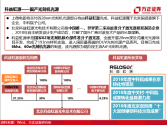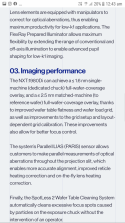Someone posted a chart from ASML here once that showed the major difference between DUVi machines wasn't power source output or numerical aperture of the optics, but the accuracy of the workpiece. Given the progress posted here regarding China's grating interferometers, I'm positive this won't be a bottleneck going forward.2000i has a higher wph and better overlay accuracy? Is there any other advantage?
You are using an out of date browser. It may not display this or other websites correctly.
You should upgrade or use an alternative browser.
You should upgrade or use an alternative browser.
Chinese semiconductor industry
- Thread starter Hendrik_2000
- Start date
- Status
- Not open for further replies.
You mean the MMO, you can see that SSA 800 28 DUVL had the same MMO with ASML NXT 1980i.Someone posted a chart from ASML here once that showed the major difference between DUVi machines wasn't power source output or numerical aperture of the optics, but the accuracy of the workpiece. Given the progress posted here regarding China's grating interferometers, I'm positive this won't be a bottleneck going forward.
DUV product portfolio to support all market segments 29 Sept. 2021 Slide 9 NXT:2100i 1.3 nm | 295wph NXT:2050i 1.5 nm | 295wph NXT:1980Ei 2.5 nm | 295wph NXT:2000i 2.0 nm | 275wph NXT:1980Di 2.5 nm | 275wph ArF XT:1460K 5 nm | 205wph or 7.5 nm| 228wph 1.35 NA, 38 nm 0.93 NA, 57 nm XT:860N 7.5 nm | 260wph XT:1060K + PEP 5 nm | 220wph XT:860M 7 nm** | 240 - 250wph XT:1060K 5 nm | 205wph 0.93 NA, 80 nm 0.80 NA,110 nm i-line XT:400M 2
By @WTAN
The stated MMO of SMEE DUVL is 2.5nm
The MMO of ASML 1980i is 2.5nm
The MMO/CMO of 2000i is 2.5nm
The MMO/CMO of 2050i is 2.5nm
The 2000i and 2050i have a ORION Alignment Sensor so the MMO is probably better than 2.5nm.
I would say that the SMEE 28nm DUVL is broadly equivalent to the 1980i.
Based on the SMEE MMO of 2.5nm which is similar to that of the 1980i, it should be able to do the 14nm process with Multi Patterning.
The 1980i is used by SMIC in China to produce 14nm ICs and the N+1(8nm) and N+2(7nm).
TSMC may have used the 1980i to produce their DUVL 7nm ICs.
SMEE will no doubt seek to improve the Overlay Accuracy of their DUVL so that it can match the latest NIKON DUVL in order to enable the production of 5nm ICs.
They should be able to achieve this as their MMO is already quite advanced by ASML and NIKON standards.
Attachments
This is kind of interesting. Based on what @hvpc explained to me, SMSC Fab 8-P2 is SN1 and Fab8-P3 in SN2
I see some competitive bidding projects here
This one has UPS Power (backup power I guess) added to SN1 and work is to be concluded by August. I don't know if this means SN1 is doing this now because it's concerned about bad actors or national security or some other reasons. Maybe the power requirement is higher. Who knows
The following are all for SN2
this one is asking for bidding of some gas system and to be complete by March 2024
this one is asking for bidding of power system and to be complete by May 2024
this one is bidding for gas detecting and gas monitoring system. doesn't have projection completion time
This one is for waste water system and to be completed by July 1st 2024
Now, I don't think they need to wait until all these projects are done before starting to move in equipments and adjusting production line. But it does look to me that SN2 is not going to start production until 2nd half of 2024. I don't know if things got slowed down due to October sanctions or due to demand or shifting priorities, but this is slower than I had expected. Since I remember reading that construction had started in early 2022 and I had anticipated about 18 months (so second half of 2023).
Unless they are able to find more space or greater efficiency in their SN1, the most Finfet production they can do is around 35k wpm for the next 15 to 18 month.
I do have to say that if they still cannot have a de-Americanized 12nm (or N+1) production process by then, they should be embarrassed.
I see some competitive bidding projects here
This one has UPS Power (backup power I guess) added to SN1 and work is to be concluded by August. I don't know if this means SN1 is doing this now because it's concerned about bad actors or national security or some other reasons. Maybe the power requirement is higher. Who knows
The following are all for SN2
this one is asking for bidding of some gas system and to be complete by March 2024
this one is asking for bidding of power system and to be complete by May 2024
this one is bidding for gas detecting and gas monitoring system. doesn't have projection completion time
This one is for waste water system and to be completed by July 1st 2024
Now, I don't think they need to wait until all these projects are done before starting to move in equipments and adjusting production line. But it does look to me that SN2 is not going to start production until 2nd half of 2024. I don't know if things got slowed down due to October sanctions or due to demand or shifting priorities, but this is slower than I had expected. Since I remember reading that construction had started in early 2022 and I had anticipated about 18 months (so second half of 2023).
Unless they are able to find more space or greater efficiency in their SN1, the most Finfet production they can do is around 35k wpm for the next 15 to 18 month.
I do have to say that if they still cannot have a de-Americanized 12nm (or N+1) production process by then, they should be embarrassed.
What do you guys make of the SCMP article quoting an anonymous Chinese chip industry investor: “Domestic producers can make photoresist for legacy nodes, but the high-end photoresist is still very difficult to produce locally”
It turns out that Japanese companies hold 75% of the world’s high-end photoresist market. Japan dealt a heavy blow to Korea’s semiconductor industry by temporarily denying them access to its photoresist and related chemicals a few year ago.
According to Zheshang Securities, the ratio of China’s local supply is less than 2% for high-level Arf photoresist consumption.
It turns out that Japanese companies hold 75% of the world’s high-end photoresist market. Japan dealt a heavy blow to Korea’s semiconductor industry by temporarily denying them access to its photoresist and related chemicals a few year ago.
According to Zheshang Securities, the ratio of China’s local supply is less than 2% for high-level Arf photoresist consumption.
It’s not that simple. There’s far more to “accuracy” than interferometers.Someone posted a chart from ASML here once that showed the major difference between DUVi machines wasn't power source output or numerical aperture of the optics, but the accuracy of the workpiece. Given the progress posted here regarding China's grating interferometers, I'm positive this won't be a bottleneck going forward.
If a DUVi system has a higher throughput than an older model then it must be able to deliver a higher average illumination power on the wafer. This can be a combination of improvements to source power and optical path performance.
You are talking about the throughput which is a combination of power of the ArF laser and the speed of the wafer stage, he is referring to the overlay matching accuracy is which accurate interferometers play a big role along the accurate matching of the alignment marks.It’s not that simple. There’s far more to “accuracy” than interferometers.
If a DUVi system has a higher throughput than an older model then it must be able to deliver a higher average illumination power on the wafer. This can be a combination of improvements to source power and optical path performance.
Regarding the laser, RSLaser ArF excimer laser already archived 60W 6KHZ according to sources which is good enough for high throughput manufacturing,

Well as bad as it is, it could have been much worse. Imagine if all this sanctions were put into place all at once a few years ago. The sanctions are being drip fed just enough to allow the industry to struggle, not to kill it entirely. I think it's on purpose too. Washington must know that they can't hit push China too far into the corner, otherwise China will start hitting back hard. They probably also don't want the entire chinese semiconductor industry to collapse, the economic shock will hurt the entire world badly.
But this means that the sanctions will keep coming. There's no real limit to what America can and will do. Once China gets high end DUVi and EUV to start working and the technological issues sorted out, there's tons of other areas that they can hit back, there could be massive bans on even buying or using chinese chips, banning chinese companies from SWIFT and other such drastic sanctions that we currently see on Iran and Russia. IMO, China needs to prepare for that even once the current technological issues have been solved.
But this means that the sanctions will keep coming. There's no real limit to what America can and will do. Once China gets high end DUVi and EUV to start working and the technological issues sorted out, there's tons of other areas that they can hit back, there could be massive bans on even buying or using chinese chips, banning chinese companies from SWIFT and other such drastic sanctions that we currently see on Iran and Russia. IMO, China needs to prepare for that even once the current technological issues have been solved.
Congress already backed off on a bill to stop purchases of things containing Chinese chips iircWell as bad as it is, it could have been much worse. Imagine if all this sanctions were put into place all at once a few years ago. The sanctions are being drip fed just enough to allow the industry to struggle, not to kill it entirely. I think it's on purpose too. Washington must know that they can't hit push China too far into the corner, otherwise China will start hitting back hard. They probably also don't want the entire chinese semiconductor industry to collapse, the economic shock will hurt the entire world badly.
But this means that the sanctions will keep coming. There's no real limit to what America can and will do. Once China gets high end DUVi and EUV to start working and the technological issues sorted out, there's tons of other areas that they can hit back, there could be massive bans on even buying or using chinese chips, banning chinese companies from SWIFT and other such drastic sanctions that we currently see on Iran and Russia. IMO, China needs to prepare for that even once the current technological issues have been solved.
- Status
- Not open for further replies.

